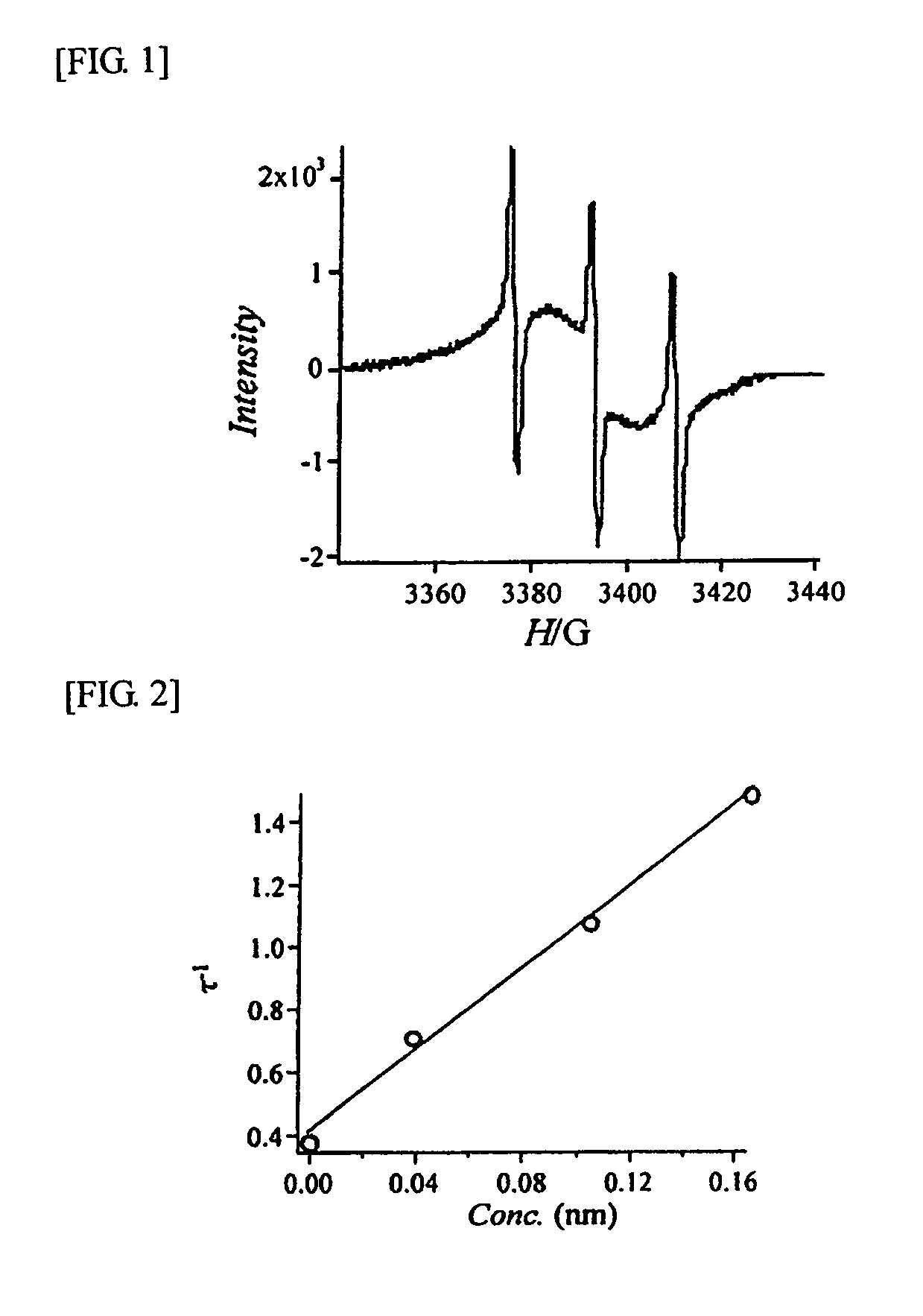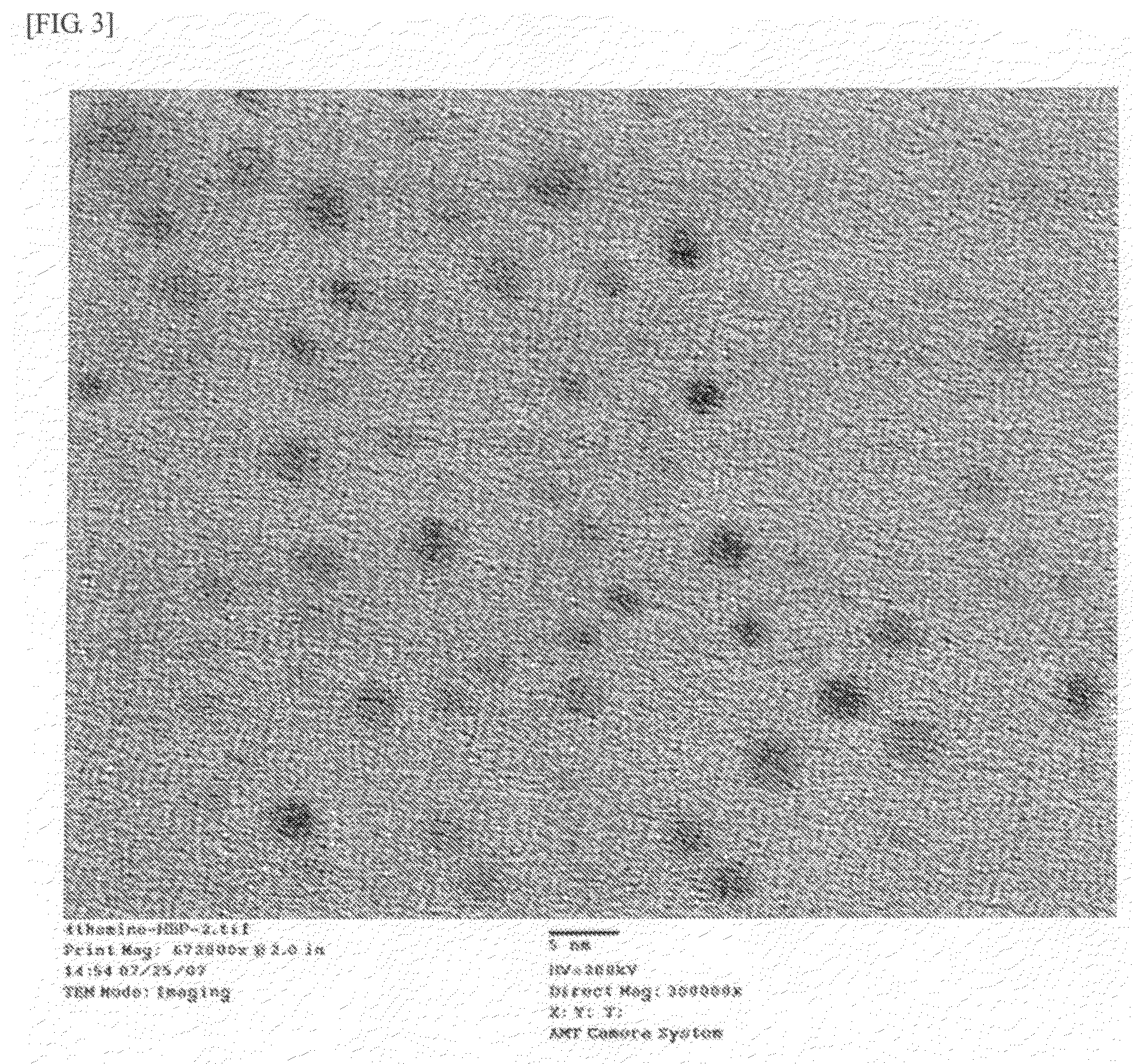Hyperbranched polymer having nitroxyl group
a polymer and nitroxyl group technology, applied in the field of hyperbranched polymers having nitroxyl group, can solve the problems of low relaxivity of contrast agents and the safety of contrast agents in organisms, and achieve the effects of low viscosity, excellent water solubility, and high relaxivity
- Summary
- Abstract
- Description
- Claims
- Application Information
AI Technical Summary
Benefits of technology
Problems solved by technology
Method used
Image
Examples
reference example 1
Synthesis of N,N-diethyldithiocarbamylmethylstyrene
[0081]
[0082]Into a 2 L reaction flask, 120 g of chloromethylstyrene (manufactured by AGC Seimi Chemical Co., Ltd.; trade name: CMS-14), 181 g of sodium N,N-diethyldithiocarbamate trihydrate (manufactured by Kanto Chemical Industry Co., Inc.) and 1,400 g of acetone were charged and the reaction was effected while stirring the resultant mixture at 40° C. for 1 hour. After the completion of the reaction, deposited sodium chloride was removed by filtering and thereafter, acetone was distilled off from the reaction solution using an evaporator to produce a reaction crude powder. The reaction crude powder was re-dissolved in toluene and the resultant toluene / water phases were separated, followed by recrystallizing the objective substance in the toluene phase in a refrigerator of −20° C. The recrystallized substance was filtered and vacuum dried to produce 206 g (yield: 97%) of the objective substance as a white powder. The purity (area pe...
reference example 2
[0083]
[0084]Into a 300 mL reaction flask, 108 g of N,N-diethyldithiocarbamylmethylstyrene obtained in Reference Example 1 and 72 g of toluene were charged and the resultant mixture was stirred to prepare a light yellow transparent solution, and then the inside of the reaction system was purged with nitrogen. From the center of the solution, a high pressure mercury-vapor lamp of 100 W (manufactured by Sen Lights Corporation; HL-100) was lighted to effect a photopolymerization reaction by an internal irradiation at a temperature of 30° C. for 12 hours while stirring the reaction solution. Next, the reaction solution was added to 3,000 g of methanol to reprecipitate a polymer in a massive state having high viscosity and then, supernatant fluid was removed by decantation. Further, the polymer was redissolved in 300 g of tetrahydrofuran and then, the resultant solution was added to 3,000 g of methanol to reprecipitate the polymer in a slurry state. The slurry was filtered and vacuum drie...
reference example 3
[0085]
[0086]Into a 300 mL reaction flask equipped with a reflux tower, 10 g of the hyperbranched polymer having a dithiocarbamate group at the molecular terminal thereof obtained in Reference Example 2 and 50 g of chloroform were charged and the inside of the reaction system was purged with nitrogen. Into the resultant mixture, a solution in which 16.0 g of bromine (manufactured by Junsei Chemical Co., Ltd.) was dissolved in 50 g of chloroform was dropped and the resultant mixture was refluxed for 3 hours. The resultant reaction mixture was cooled down to a temperature of 30° C. and the generated orange precipitate was filtered off.
[0087]To the resultant filtrate, a saturated saline and 20% by mass sodium thiosulfate were added and the organic phase was washed. The resultant solution was dropped into 500 g of methanol to perform reprecipitation. The obtained yellow powder was dissolved one more time in 40 g of chloroform and the resultant solution was dropped into 500 g of methanol ...
PUM
| Property | Measurement | Unit |
|---|---|---|
| particle diameter | aaaaa | aaaaa |
| reaction temperature | aaaaa | aaaaa |
| reaction temperature | aaaaa | aaaaa |
Abstract
Description
Claims
Application Information
 Login to View More
Login to View More - R&D
- Intellectual Property
- Life Sciences
- Materials
- Tech Scout
- Unparalleled Data Quality
- Higher Quality Content
- 60% Fewer Hallucinations
Browse by: Latest US Patents, China's latest patents, Technical Efficacy Thesaurus, Application Domain, Technology Topic, Popular Technical Reports.
© 2025 PatSnap. All rights reserved.Legal|Privacy policy|Modern Slavery Act Transparency Statement|Sitemap|About US| Contact US: help@patsnap.com



